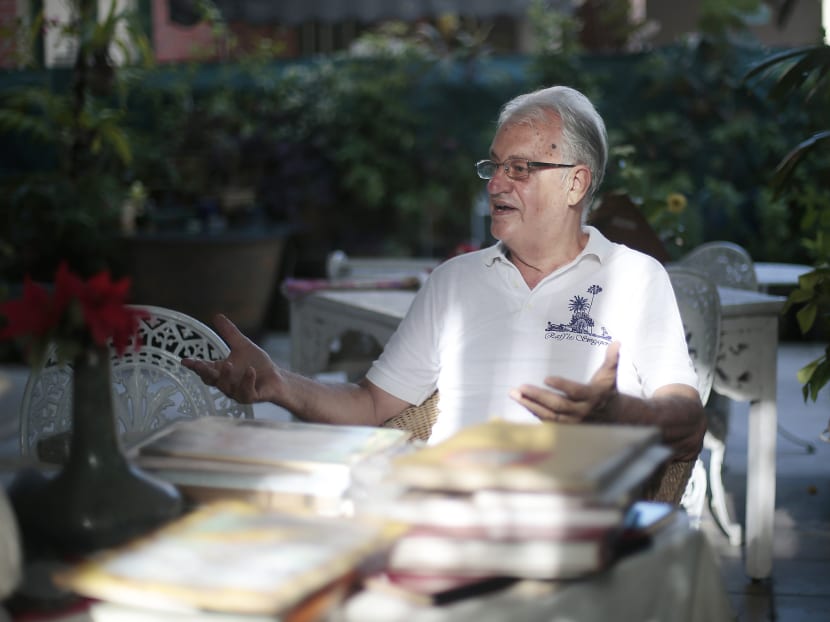Build on Raffles Hotel’s heritage, ‘so that people have reason to come’
SINGAPORE — On his first day as manager of Raffles Hotel in 1972, only 15 of its 127 rooms were occupied. The hotel was increasingly being seen as a colonial relic, and Mr Roberto Pregarz’s predecessor told him that it would close down in six months.
SINGAPORE — On his first day as manager of Raffles Hotel in 1972, only 15 of its 127 rooms were occupied. The hotel was increasingly being seen as a colonial relic, and Mr Roberto Pregarz’s predecessor told him that it would close down in six months.
But the Italian was undeterred, saying he would be honoured to be its manager, even for six months. Instead, he lasted 17 years, and managed to get the hotel gazetted as a national monument along the way.
In the wake of news last week that French operator AccorHotels had agreed to buy FRHI Holdings — the company that owns the Raffles, Fairmont and Swissotel brands — Mr Pregarz expressed hope that the hotel’s rich history would be revived and that it would again become a “rendezvous for writers and personalities”.
“There are many beautiful hotels in Singapore, but none can match Raffles for its rich history immortalised by famous writers for over 100 years!” said Mr Pregarz, 75, who joined as assistant manager in 1967 and left in 1989 when it closed for extensive renovations. “‘We’ll meet at Raffles’ should become again the magic word known all over the world for Singapore.”
The latest news involving the storied landmark — which AccorHotels reportedly said would not affect Raffles Hotel’s ownership as it had a “long-term management contract” for the hotel under the agreement with FRHI Holdings — was “normal” for Mr Pregarz, as it has changed hands several times in the past decade.
Since he left the hotel, he has felt a dilution of its iconic status as it became less open to journalists and film crews, and as other hotels such as Fullerton Hotel and Marina Bay Sands came to the fore.
Raffles Hotel was fairly run-down when he took over as manager, but he worked around the small budget for renovations and maintenance, and the nonexistent budget for marketing and advertising.
When four directors of the tourism board knocked on his door wanting to use Raffles Hotel to promote Singapore in Australia, the United States, the United Kingdom and Japan, he welcomed the journalists and writers sent his way. Momentum increased and the result was several books written, and television series and movies made, showcasing the hotel.
Mr Pregarz recalled with relish how the Palm Court, an area to the right of the main entrance, was a centre of activity with singing birds during breakfast, tiffin lunches and candlelight dinners. He added pizzazz to the Singapore Sling recipe and moved the Long Bar closer to the lobby.
From 10 Singapore Slings sold a day when he started as manager, the number rose to 1,200 by the time he left. He created more souvenirs to sell and they eventually raked in S$150,000 a month for the hotel.
He turned Raffles Hotel’s centenary in 1986 into a “jackpot year”. That year was a crisis for the hotel industry and a new hotel nearby offered cabin crew rates of S$40 a night. Raffles Hotel’s rate was more than S$100, but it was practically booked out the entire year, with promotions lasting from Christmas in 1985 to Chinese New Year in 1987.
Legend had it that a tiger was shot dead under a billiard table in the hotel in the early 1900s. In the Year of the Tiger, 1986, a circus was in town and Mr Pregarz set about borrowing a tiger from the circus as a highlight of the celebrations at the hotel. He cut through layers of red tape through sheer persistence and took the required precautions. In February that year, a Bengal tiger on the billiard table of the Tiffin Room became a hit with the media. He had not sought the go-ahead from his chairman before the stunt.
Recounting the story in his 1990 book, Memories of Raffles, Mr Pregarz wrote: “My chairman later confirmed he would not have given his permission, but he thought that ... it wasn’t a bad idea.”
A grandfather of four, Mr Pregarz first sailed to Singapore when he was managing a restaurant on a passenger liner in 1959. He was offered a job in 1966 by the manager of Raffles Hotel, who was also Italian, and met his Singaporean wife, Helena, in 1968 at the American Club.
The hotelier was not only about creativity and making money, he kept communication lines open with staff and guests, and would readily roll up his sleeves to help repair a leaking roof.
He told staff to direct all complaints to him, saying: “Not that I am better than you (but) when a guest who makes a complaint has the opportunity to speak to the top man, already 50 per cent is solved.”
Giving his take on what can now be done to elevate the grand dame he saved more than 40 years ago, Mr Pregarz said: “Raffles can be different if you not only promote the history, but develop and continue to create events around the history of the hotel, so people have a reason to come.”







